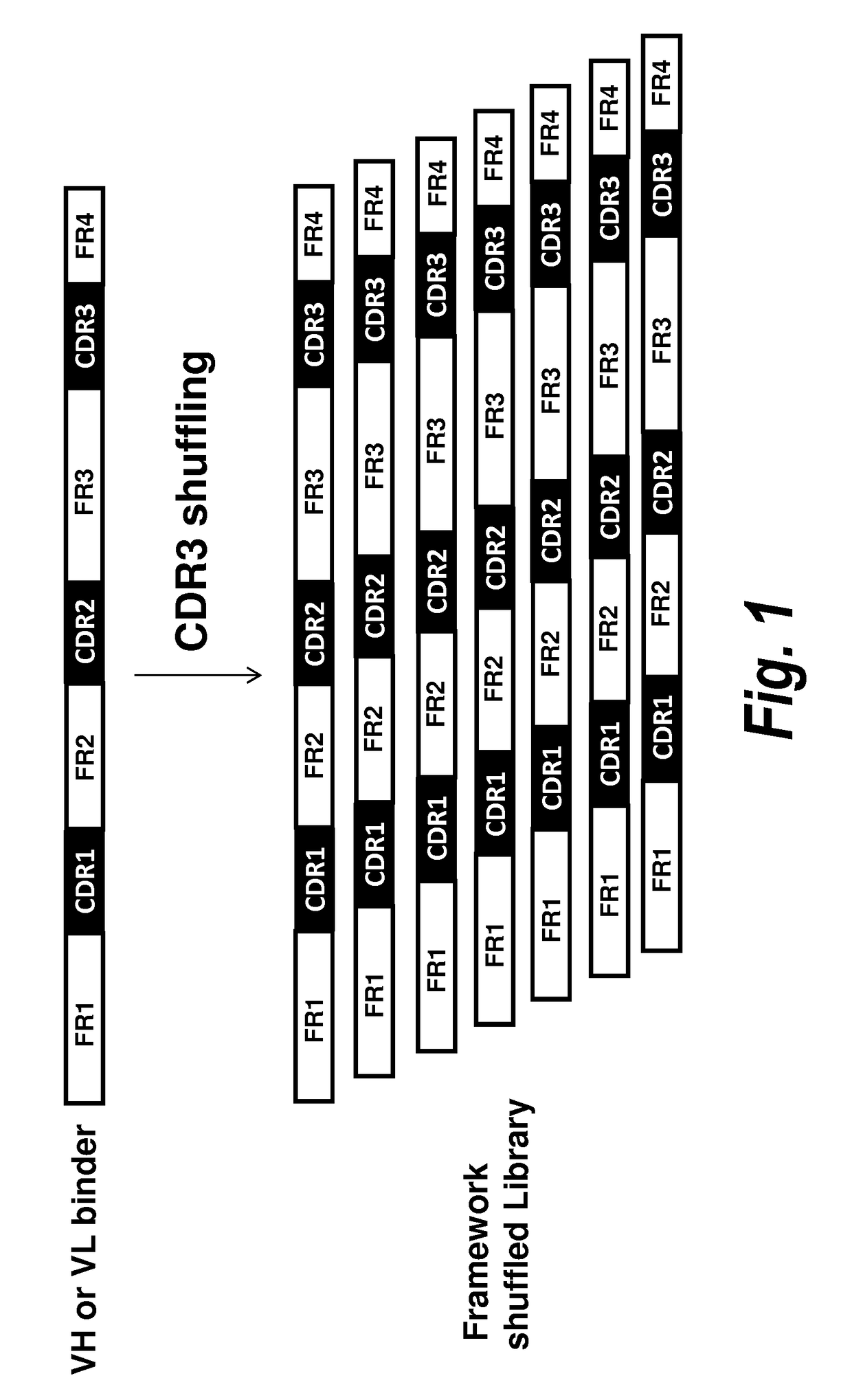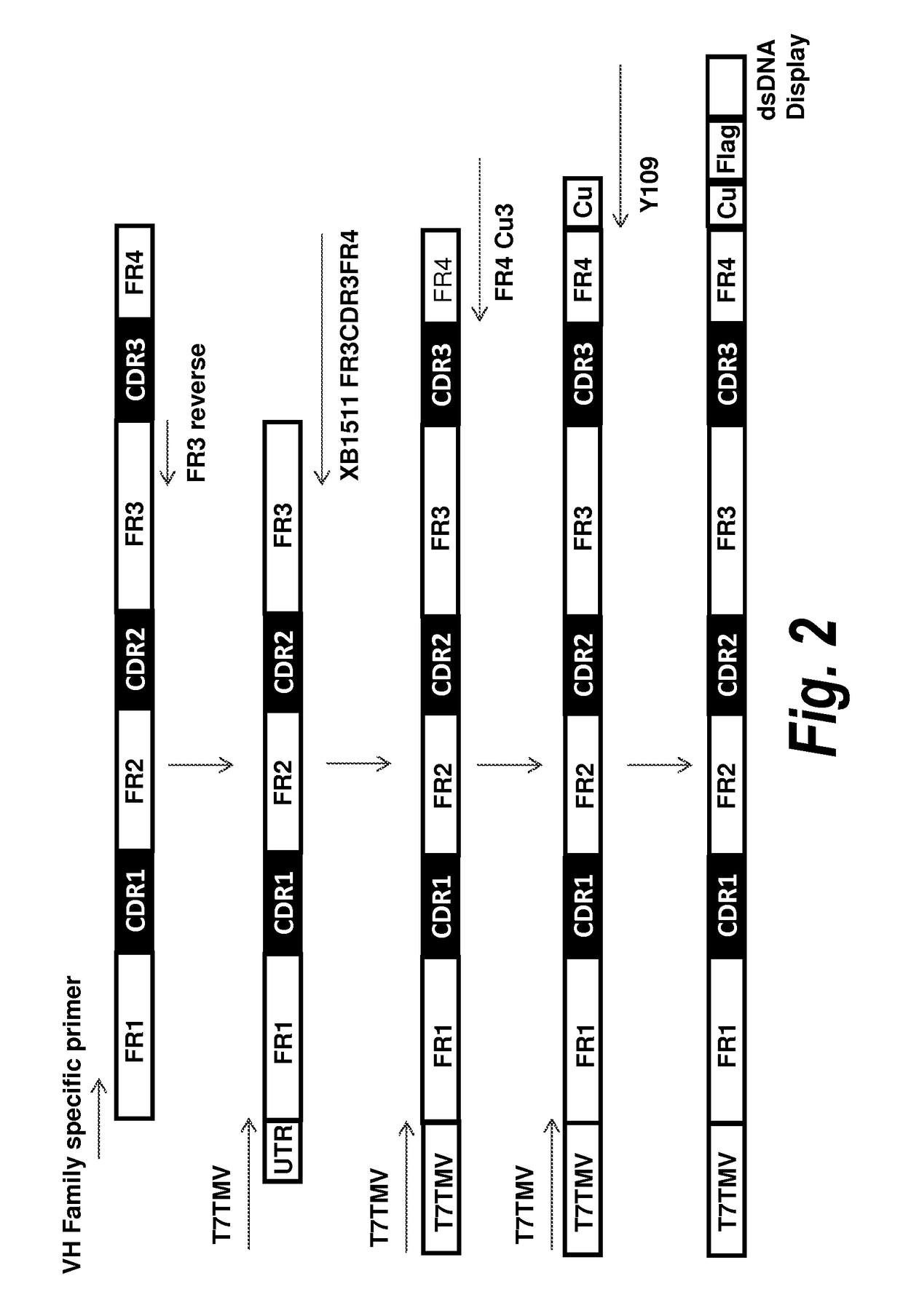Antibody screening methods
a technology of antibody and screening method, applied in the field of antibody screening method, can solve the problems of slow and cumbersome classical methods of immunizing animals to obtain antibodies, still relatively difficult to obtain antibodies that possess the desired kinetic properties, selectivity, biophysical properties, and immunogenicity necessary for therapeutic use, and achieve the effect of improving properties
- Summary
- Abstract
- Description
- Claims
- Application Information
AI Technical Summary
Benefits of technology
Problems solved by technology
Method used
Image
Examples
example 1
of VH Domains that Bind Specifically to Human PDGFRb
[0091]VH domains that bind specifically to human PDGFRb were selected using DNA display as set forth in WO2010 / 011944, which is hereby incorporated by reference in its entirety. Specifically, a naïve, human VH domain DNA display library containing derived from 10 bone marrow donors was subject to six rounds of selection against human PDGFRb. The selected binders were cloned and sequenced. From this screen VH domain clones A4, B4 and G2 were selected, the amino acid sequences of which are set forth in Table 1.
[0092]
TABLE 1Amino acid sequences of exemplary PDGFRb-binding VH domains.CloneSEQ IDnameVH Amino Acid SequenceNO.A4QVQLVQSGAEVKKPGSSVKVSCKASGGTFSSYAISWVRQAPGQG1XB1511LEWMGGIIPIFGTANYAQKFQGRVTITADESTSTAYMELSSLRSEDTAVYYCAIHGGDRSYWGQGTLVTVSSB4QVQLVQSGAEVKKPGASVKVSCKASGYTFTSYAISWVRQAPGQG2LEWMGGIIPIFGTANYAQKFQGRVTITADESTSTAYMELSSLRSEDTAVYYCAIHGGDRSYWGQGTLVTVSSG2QVQLVQSGAEVKKPGASVKVSCKASGYTFTGYAISWVRQAPGQG3LEWMGGIIPIFGTANYAQKFQGRVTIT...
example 2
ffling
A. VH Library Construction
[0093]To screen for VH domains with improved binding characteristics, the HCDR3 sequence of clone A4 (designated XB1511) was shuffled into a naïve human VH library, which was further selected for binding to human and mouse PDGFRb. Specifically, the DNA sequence coding for the HCDR3 of clone A4 (SEQ ID NO: 1) was synthesized and assembled into a library comprising framework regions 1-3 of naïve human VH domains amplified from bone marrow B cells and PBMCs using framework specific oligonucleotides. Human VH framework regions 1-3 were amplified using 5′ VH family-specific and 3′ generic FR3 reverse primers to create separate libraries of VH family framework regions. The VH family framework libraries and the XB1511 HCDR3 were shuffled by further PCR amplification using 5′ T7TMV and 3′ XB1511 FR3CDR3FR4 oligos. This also added a T7TMV promoter sequence at the 5′ end for in vitro transcription / translation. A C-terminal Cμ3 sequence and a FLAG tag (for purif...
example 3
ation of Stable VL / VH Pairs
A. Construction of VL DNA Libraries
[0099]Human VL libraries (Vkappa and Vlamda) were constructed from B cells of young healthy donors (Allcells) by RT-PCR. To ensure the diversity of the library, 300 million mononuclear cells from bone marrow of each donor and total of 10 donors and 100 million of peripheral blood mononuclear cells from each donor and total of 10 donors were obtained for naive VH and VL library construction. A schematic of the library generation method is set forth in FIG. 8.
[0100]Oligonucleotide primers for cDNA synthesis and subsequent PCR amplification of the Vkappa and Vlamda sequences were design as set forth in Table 4. Specifically, multiple sense primers were designed from the Vκ and Vλ FR1 regions of each family with an upstream UTR sequence. The anti-sense primers for κ and λ gene amplification were designed from the constant regions nested to Cκ1 (Cκ2) or Jλ with the same Cκ2 downstream (JλCκ2). The Vκ and Vλ libraries carry the...
PUM
| Property | Measurement | Unit |
|---|---|---|
| flow rate | aaaaa | aaaaa |
| concentrations | aaaaa | aaaaa |
| concentrations | aaaaa | aaaaa |
Abstract
Description
Claims
Application Information
 Login to View More
Login to View More - R&D
- Intellectual Property
- Life Sciences
- Materials
- Tech Scout
- Unparalleled Data Quality
- Higher Quality Content
- 60% Fewer Hallucinations
Browse by: Latest US Patents, China's latest patents, Technical Efficacy Thesaurus, Application Domain, Technology Topic, Popular Technical Reports.
© 2025 PatSnap. All rights reserved.Legal|Privacy policy|Modern Slavery Act Transparency Statement|Sitemap|About US| Contact US: help@patsnap.com



